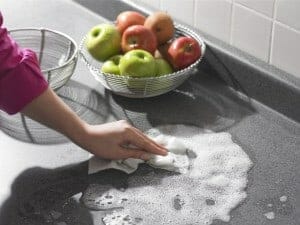 Use hot water and soap to clean the sink, counters, cutting boards, pans, knives, thermometer and other utensils and serving pieces. You might want to sanitize the countertop and your cutting boards. To do this use a diluted bleach solution of 1T unscented liquid bleach (not more) to 1 gallon of water. Let the bleach solution stand on the surface for a few minutes; then rinse and blot dry with clean paper towels.
Use hot water and soap to clean the sink, counters, cutting boards, pans, knives, thermometer and other utensils and serving pieces. You might want to sanitize the countertop and your cutting boards. To do this use a diluted bleach solution of 1T unscented liquid bleach (not more) to 1 gallon of water. Let the bleach solution stand on the surface for a few minutes; then rinse and blot dry with clean paper towels.
Have plenty of clean cloth towels (or paper towels) on hand for the meal preparation and clean-up. If you use cloth towels, wash them often in the hot cycle of your washing machine.
Clear a large enough space on the bottom shelf of the refrigerator to accommodate the turkey. Check the temperature of your refrigerator. It should be 40 °F or below as measured with an appliance thermometer.
Make sure you have a food thermometer and calibrate it if necessary. [see Speaking of Thermometers, below]
When preparing the meal, rinse fresh fruits and vegetables under running tap water, including those with skins and rinds that are not eaten. Blot dry with a clean cloth towel or paper towel.
Sharpen knives yourself or take them to a professional if necessary.
Wash your hands with warm water and soap for 20 seconds before and after handling food.
Remind others who will be in the kitchen handling food to wash their hands too.
AND SPEAKING OF THERMOMETERS …
Using a food thermometer is the only reliable way to ensure safety and to determine desired “doneness” of meat, poultry and egg products. Cooking these foods to a safe minimum internal temperature as measured with a food thermometer will destroy any harmful microorganisms.
Types of Thermometers
Food thermometers come in several types and styles, and vary in level of technology and price. To select the type that will work best for you, get more information on thermometers from USDA.
Digital Food Thermometers
Dial Food Thermometers
Single-Use Temperature Indicators
Pop-Up Timers
Using the Food Thermometer
Most available food thermometers will give an accurate reading within 2 °F to 4 °F. The reading will only be correct, however, if the thermometer is placed in the proper location in the food. If not inserted correctly, or if the food thermometer is placed in the wrong area, the reading will not accurately reflect the internal temperature of the food.
In general, the food thermometer should be placed in the thickest part of the food, away from bone, fat or gristle.
Check Manufacturer’s Instructions
Before using a food thermometer, read the manufacturer’s instructions, which should tell you how far the thermometer must be inserted in a food to give an accurate reading. If instructions are not available, check the stem of the food thermometer for an indentation, or “dimple.” This shows one end of the location of the sensing device. Dial thermometers must penetrate about 2 to 3 inches into the food. Most digital thermometers will read the temperature in a small area of the tip.
AVOID CROSS-CONTAMINATION in the KITCHEN
Wash hands with warm water and soap for at least 20 seconds before and after handling food and after using the
bathroom, changing diapers and handling pets.
In the refrigerator, store turkey and other raw foods that will be cooked on the bottom shelves and ready-to-eat foods on the top shelves. Put turkey in a rimmed pan to catch any leaking juices.
Designate separate cutting boards for raw meats or clean and sanitize cutting boards between uses for different foods.
Clean and sanitize knives between uses on different foods and place only sanitized knives back in their racks.
Sanitize any utensil, equipment or food contact surface after it has been in contact with raw foods, especially meat or eggs.
Never move boxes or containers that may have been stored on the floor onto countertops.